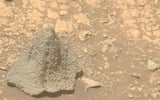NASA's Perseverance Rover Uncovers Helmet-Shaped Rock, Ignites Fascination with Mars' Geological History
August 25, 2025
NASA's Perseverance rover has discovered a helmet-shaped rock called Horneflya in Mars' Jezero Crater, which is composed mainly of spherical mineral formations known as spherules and features a pointed, helmet-like shape with a pitted, nodular texture.
This discovery provides crucial insights into Mars' geological history, including volcanic activity, water processes, and wind erosion that has shaped the landscape over time.
The high-resolution images from Perseverance's Mastcam-Z instrument reveal that Horneflya's unique shape and composition could shed light on past environmental conditions, such as groundwater interactions and volcanic cooling.
Scientists hypothesize that these spherules formed through groundwater passing through sedimentary rocks, offering clues about Mars' ancient climate and hydrological history.
Horneflya's helmet-like appearance has sparked public fascination and media buzz, with some noting its resemblance to ancient helmets worn on Earth, fueling curiosity about potential extraterrestrial life.
Discovered on August 5, 2025, the helmet-shaped rock has prompted speculation about alien origins, although scientists explain that the spherules are common on Mars and Earth, formed by natural geological processes.
Perseverance's Mastcam-Z and other instruments play a vital role in analyzing the rock's morphology, mineralogy, and potential organic compounds, helping scientists understand Mars' habitability and resource potential.
Public interest in Horneflya has grown significantly, with social media memes and widespread curiosity, inspiring the next generation of scientists and explorers.
Recent panoramic images from the rover also revealed patterns resembling Earth and heart-shaped formations, adding to the intrigue surrounding Mars' surface features.
The discovery holds broader implications, including potential economic benefits through the identification of valuable minerals for in-situ resource utilization and fostering international collaborations.
While these exciting findings advance our understanding, experts caution that human exploration of Mars remains impractical due to hazards like cosmic radiation, despite ongoing efforts by agencies and private companies.
The shape of Horneflya results from wind erosion, illustrating ongoing surface shaping processes on Mars that influence landscape features and geological evolution.
Overall, Horneflya offers vital insights into Mars' past climate, geological processes, and current surface dynamics, paving the way for future exploration and potential human habitation.
Summary based on 4 sources
Get a daily email with more Science stories
Sources

Live Science • Aug 24, 2025
NASA's Perseverance rover spies mysterious 'helmet' on Mars
OpenTools • Aug 25, 2025
NASA's Perseverance Uncovers "Horneflya": A Mysterious Hat-Shaped Rock on Mars!
OpenTools • Aug 25, 2025
NASA’s Perseverance Rover Discovers Enigmatic Helmet-Shaped Rock on Mars
Supercar Blondie • Aug 21, 2025
Scientists left confused after mysterious ‘alien helmet’ spotted on the surface of Mars